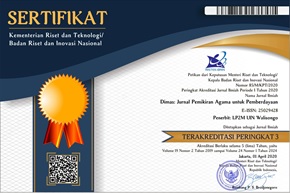Community-Based Sustainable Tourism Village through Nature and Culture Tourism
DOI:
https://doi.org/10.21580/dms.2023.231.13537Keywords:
Community based tourism, culture, citizen, nature, village tourismAbstract
The decline in visitors during the COVID-19 outbreak is one of the factors affecting the profitability of tourist destinations. This condition is challenging for developing tourist villages, especially the Hegarmukti tourist village. Several activity restrictions during the COVID-19 outbreak have made community-based tourism development programs experience obstacles. Through this community service activity, the 4C model analysis (Conservation, Community, Culture, and Commerce) is to be applied to optimize the growth of the Hergarmukti tourist village. The activity begins with a semi-formal interview process and observations to gather information. Through this activity, it was revealed that some potential has not been exploited, especially in terms of natural and cultural tourism. Socialization activities by conducting capacity-building workshops for preserving natural ecosystems through waste management were conducted with the Situ Rawa Binong residents. Besides, cultural promotion activities through local art performances displayed by the Cahaya Gumilar Art Gallery also attract tourists. To run a sustainable tourism village, the community requires soft skills training in tourism and marketing. The study also offers several possible tourist attractions to stimulate the local economy.
Downloads
References
Alfiani, M. , 2021. Analisis Manajemen Event Festival Danau Semayang Sebagai Ikon Wisata di Desa Wisata Pela, Kukar, Kalimantan Timur. STP AMPTA Yogyakarta.
Aman, O., Manap, A. A., Ismail, A. F., Kudus, N., & Rahmiati, F. (2013). The impact of tourism innovation on quality of life of residents in the community: a case study of Sungai Melaka. Journal of Human Capital Development (JHCD), 6(1), 27-40.
Aziz, M. F., Handayani, S., and Nasution, H. M. A. A. , 2020. Telaah Yuridis Investasi Pemerintah Dalam Menyelamatkan UMKM Pariwisata Akibat Pandemi Covid-19. Jentera:Jurnal Hukum, 3(1), pp. 202–215.
Bole, D., Smid Hribar, M., and Pipan, P. , 2017. Participatory research in community development: A case study of creating cultural tourism products. Acta Universitatis Carolinae, Geographica, 52(2), pp. 164–175.
Bumdes Lestari Hegarmukti. , 2022. Desa Wisata Hegarmukti Diteliti Penggiat Wisata Bali, Mahasiswa dan Dosen President University. Mitranews.
Dokulil, M. T. , 2014. No Environmental Impacts of Tourism on Lakes. Eutrophication: Causes, Consequences and Control. Springer Science and Business Mdia Dordrecht, 2, pp. 81–88.
Hallaj, Z., Bijani, M., Abbasi, E., Valizadeh, N., and Mohammadi, M. , 2022. Tourism Development During the Pandemic of Coronavirus (COVID-19): Evidence From Iran. Frontiers in Public Health, 10, pp. 1–10.
Human Kabupaten Bekasi. , 2019. Pemkab Bekasi Jadikan Rawa Binong Sebagai Wisata Andalan.
Ismail, Y., and Vennecya, D. , 2022. Study of People’s Opinion about Tanjung Lesung Tourist Destination. Journal of Community Development in Asia, 5(1), pp. 30–40.
Lestari, B. H. , 2019. Rencana Strategis Pengembangan Pariwisata Desa Hegarmukti Kecamatan Cikarang Pusat Kabupaten Bekasi.
Li, Z., Zhang, X., Yang, K., Singer, R., and Cui, R. , 2021. Urban and rural tourism under COVID-19 in China: research on the recovery measures and tourism development. Tourism Review, 76(4), pp. 718–736.
Pamulardi, B. , 2006. Pengembangan Agrowisata Berwawasan Lingkungan (Studi Kasus Desa Wisata Tingkir, Salatiga). Universitas Diponegoro.
Rahmiati, F., Othman, N. A., & Hayati Tahir, M. N. (2020). Examining the trip experience on competitive advantage creation in tourism.
Rahmiati, F., Amin, G., Widyanto, H. A., and Goenadhi, F. , 2021. Discover the Potential of Community-Based Tourism in Kutu Wetan Village. The 4th International Conference and Community Development (ICCD), 3(1), pp. 35–39.
Sasongko, G., Trianggono, B., and Wiloso, P. G. , 2019. Development of Community-Based Tourism in Pinusan Kragilan, Pogalan Village, Magelang Regency, Central Java, Indonesia. Journal of Indonesian Tourism and Development Studies, 7(3), pp. 156–165.
Singgalen, Y. A., Sasongko, G., and Wiloso, P. G. , 2019. Community participation in regional tourism development: a case study in North Halmahera Regency - Indonesia. Insights into Regional Development, 1(4), pp. 318–333.
The Long Run. , 2020. Conservation and community must come first for tourism to recover responsibly and build back better for people and planet.
Thetsane, R. M. , 2019. Local Community Participation in Tourism Development: The Case of Katse Villages in Lesotho. Athens Journal of Tourism, 6(2), pp. 123–140.
UNWTO. , 2017. Tourism and the Sustainable Development Goals – Journey to 2030.
UNWTO. , 2020. COVID-19: putting people first.
World Travel Tourism Council. , 2019. Travel & Tourism Economic Impact 2019 World.
Downloads
Published
Issue
Section
License
Copyright
The copyright of the received article shall be assigned to the journal as the publisher of the journal. The intended copyright includes the right to publish the article in various forms (including reprints). The journal maintains the publishing rights to the published articles. Therefore, the author must submit a statement of the Copyright Transfer Agreement.*)
Licensing

This work is licensed under a Creative Commons Attribution-ShareAlike 4.0 International License.
In line with the license, authors are allowed to share and adapt the material. In addition, the material must be given appropriate credit, provided with a link to the license, and indicated if changes were made. If authors remix, transform or build upon the material, authors must distribute their contributions under the same license as the original.
_______
*) Authors whose articles are accepted for publication will receive confirmation via email and send a Copyright Transfer Agreement.









